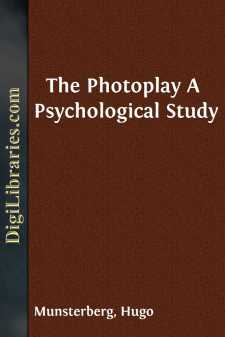Categories
- Antiques & Collectibles 13
- Architecture 36
- Art 48
- Bibles 22
- Biography & Autobiography 813
- Body, Mind & Spirit 142
- Business & Economics 28
- Children's Books 14
- Children's Fiction 11
- Computers 4
- Cooking 94
- Crafts & Hobbies 4
- Drama 346
- Education 46
- Family & Relationships 57
- Fiction 11829
- Games 19
- Gardening 17
- Health & Fitness 34
- History 1377
- House & Home 1
- Humor 147
- Juvenile Fiction 1873
- Juvenile Nonfiction 202
- Language Arts & Disciplines 88
- Law 16
- Literary Collections 686
- Literary Criticism 179
- Mathematics 13
- Medical 41
- Music 40
- Nature 179
- Non-Classifiable 1768
- Performing Arts 7
- Periodicals 1453
- Philosophy 64
- Photography 2
- Poetry 896
- Political Science 203
- Psychology 42
- Reference 154
- Religion 513
- Science 126
- Self-Help 84
- Social Science 81
- Sports & Recreation 34
- Study Aids 3
- Technology & Engineering 59
- Transportation 23
- Travel 463
- True Crime 29
Hugo Munsterberg
Hugo Münsterberg was a German-American psychologist and philosopher, known for his contributions to applied psychology. He wrote extensively on various topics, including clinical psychology, forensic psychology, and industrial psychology, helping to establish psychology as a respected scientific discipline. His influential works include "Psychotherapy" (1909) and "On the Witness Stand" (1908), which addressed the psychological aspects of legal testimony. Münsterberg was also a key figure in early film theory, exploring the psychological effects of cinema in his book "The Photoplay: A Psychological Study" (1916).
Author's Books:
Sort by:
by:
Hugo Munsterberg
PREFACE It has always seemed to me a particular duty of the psychologist from time to time to leave his laboratory and with his little contribution to serve the outside interests of the community. Our practical life is filled with psychological problems which have to be solved somehow, and if everything is left to commonsense and to unscientific fancies about the mind, confusion must result, and the...
more...
by:
Hugo Munsterberg
I. THE PROBLEM OF ANÆSTHESIA DURING EYE-MOVEMENT. A first suggestion of the possible presence of anæsthesia during eye-movement is given by a very simple observation. All near objects seen from a fairly rapidly moving car appear fused. No further suggestion of their various contour is distinguishable than blurred streaks of color arranged parallel, in a hazy stream which flows rapidly past toward the...
more...
by:
Hugo Munsterberg
CHAPTER I THE OUTER DEVELOPMENT OF THE MOVING PICTURES It is arbitrary to say where the development of the moving pictures began and it is impossible to foresee where it will lead. What invention marked the beginning? Was it the first device to introduce movement into the pictures on a screen? Or did the development begin with the first photographing of various phases of moving objects? Or did it start...
more...
by:
Hugo Munsterberg
INTRODUCTION APPLIED PSYCHOLOGY Our aim is to sketch the outlines of a new science which is to intermediate between the modern laboratory psychology and the problems of economics: the psychological experiment is systematically to be placed at the service of commerce and industry. So far we have only scattered beginnings of the new doctrine, only tentative efforts and disconnected attempts which have...
more...





